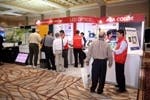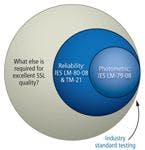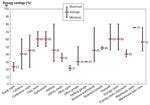+++++
This article was published in the October 2012 issue of LEDs Magazine.
View the Table of Contents and download the PDF file of the complete October 2012 issue, or view the E-zine version in your browser.
+++++
Solid-state lighting (SSL) is simply a different beast than legacy light sources. Presentations at The LED Show in Las Vegas, NV made that fact perfectly clear as product developers and lighting designers were instructed in the subtleties of LED sources, the complexities of driver electronics, and the different ways in which SSL should be applied. Exhibitors also covered the entire supply chain from components to end products (Fig. 1). Together the exhibits and sessions were a good match for the audience that in large part seemed relatively new to LED technology. Still there were informational nuggets for everyone as we will report here.
Richards said concerns about poor quality products derailing the momentum of SSL was the factor that led Cree to create the Thermal Electrical Mechanical Photometric Optical (TEMPO) testing program that is offered to luminaire makers. Richards unveiled a number of interesting facts about TEMPO. He said Cree hadn’t limited the testing program to luminaires based on Cree LEDs. And he said that Cree was willing to share its testing techniques to help move the industry forward.
System tests
Richards also discussed some examples of tests that Cree performs. For example, the company performs thermal imaging on the electrolytic capacitor in the driver electronics of an SSL product under test, since that capacitor is known as a primary source of failure in SSL products. Cree then provides the luminaire designer with a projection of the lifetime of that capacitor based on its specs and the condition under which it is being operated.
Cree has also stressed in the past that product makers must understand the chemical interactions between the varied elements that comprise a lamp or luminaire. Outgassing that occurs during operation at temperature can cause failures such as yellowing of optics and a significant reduction of lumen output. During TEMPO testing, Cree creates a test circuit board and exposes the LEDs used in the product under test to the chemicals present in other elements of the design – such as glues, seals, potting materials, and conformal coatings – to find problematic interactions.
The point to much of Richards presentation is that industry standards such as LM-79 and LM-80 don’t ensure quality products (Fig. 2). Cree believes TEMPO can cover the additional areas of product design that matter in terms of quality. Other things TEMPO includes are a look at flicker issues, solder quality, dimmer compatibility, and the ability of a design to withstand electrical spikes.
One other surprise in Richards’ talk was his assertion that even large lighting companies are using the TEMPO service despite having their own testing equipment. Generally the assumption was that smaller companies without comprehensive labs would most benefit from TEMPO. Presumably Cree’s testing confirms the products’ performance or perhaps finds something the manufacturer missed bringing value to organizations of all sizes. Richards closed noting customer successes, saying a South African lighting manufacturer won a contract to supply 50,000 LED downlights to Kentucky Fried Chicken restaurants after showing a TEMPO report to the customer.
Posselt presented LED arrays as one way to mitigate the cost issue. He used retail applications as an example. Generally stores want high-quality lights to highlight merchandise. And as you move to the high end of the retail market the demand can be for very high-quality lights.
For such high-end applications, Bridgelux offers its Decor line of arrays that feature a color rendering index (CRI) of 97. The company also has similar arrays in 80- and 90-CRI versions. Posselt said a company can design one product and drop in the array that matches customer requirements. The lighting maker may sell a majority of the 80-CRI products but can supply the higher-end versions when needed.
Still, LED component cost remains an issue upon which everyone is focused – even though the LED or LEDs are rarely the most expensive portion of an SSL product these days. Posselt touted Bridgelux’s work on gallium-nitride-on-silicon (GaN-on-Si) manufacturing as the ultimate path to lower cost. Toshiba recently announced plans to manufacture such LEDs this year using licensed Bridgelux technology.
LEDs on silicon
Silicon-based manufacturing, as opposed to the use of sapphire substrates, could reduce costs in a number of ways. The silicon wafers cost less and are more widely available. But it’s the automation of the back end of the LED manufacturing process that is the key. A move to silicon would take advantage of automation from the IC industry.
Posselt suggested that anyone that had visited both an LED fab and an IC-industry fab would know the difference. About an LED fab he said, “It almost looks like child’s play in a garage versus high-volume semiconductor manufacturing.” And he said every LED maker was working on silicon manufacturing whether they would admit it or not.
Abdul Aslami, regional sales manager with Nichia, followed Bridgelux and mainly touted the scale of the company and the breadth of its product line. Nichia is the largest LED maker globally. Aslami said that the company manufactures 2.2 billion LEDs per month at its main plant in Japan.
Aslami also said that Nichia would not compete with its customers that make lighting products, by manufacturing its own SSL products. Obviously Cree does so to some extent with Cree Lighting. And other vertically-integrated companies such as Osram and Philips do as well.
LED source size
The final speaker from the component area was Chuck DeMilo, director of product marketing at Luminus Devices. DeMilo discussed the challenge of difficult retrofit lamp applications such as replacing a 50W halogen MR16 with LEDs. Quickly summarized, the challenge is delivering more than 750 lm with tight beam control. Moreover you are limited to 8-10W in power dissipation to stick with a passive cooling scheme according to DeMilo. He said ideally you would use the smallest possible point source for such an application, but unfortunately you need a fairly large emitting area to generate the required light output.
Luminus was founded around the concept of making larger LED chips that in turn can support higher current density and produce more lumens. But Luminus also makes multi-die LED packages now that can be simpler to drive in an application such as an MR16 driven from line voltage.
DeMilo said in the end that input voltage considerations may guide the choice of LEDs. The company offers a 4-die LED that has a forward voltage of 12V that is a better fit for line-voltage applications. Alternatively, they offer a single-die LED with a forward voltage of 3.1V that is a better fit for 12V DC or transformed AC track lighting. Both products deliver 850 lm and a CRI of 80.
Still DeMilo warned of one other issue when you work with multi-die LEDs. He said, “When you use multiple emitters in a packaged LED, the source can get reimaged out in your beam pattern.” For more information on that topic, view our recent Webcast on packaged LEDs.
Controlling light
Following the LED manufacturers, a number of executives from lighting companies made presentations including John Selander, director of specification sales at Acuity Brands. Selander’s talk was on intelligent digital lighting. Intended or not, the word intelligent both implied intelligence in lighting fixtures and in the people who design and install lighting. Slashing energy and improving lighting comes down to the simple concept of putting the right level of light where it is needed and only where it is needed according to Selander. He said, “Use the right amount of light for the task.”
Selander also addressed the inaccuracy of what he implied was a widespread perception that SSL uptake was slow. He pointed out that it took 18 years for electronic ballasts to take over from magnetic ballasts in fluorescent. He said the tipping point came after 12 years. He said that LEDs have arrived at the tipping point in essentially only four years.
Daylighting maximizes savings
But the recurring theme in Selander’s talk was intelligent design. He focused heavily on the use of daylighting. Daylighting has the potential to provide savings when we need it the most – during the peak energy-use period in the afternoon. During a three hour period between 2:00 and 5:00 PM lighting and air conditioning can each account for as much electricity as all other elements of a commercial setting combined such as office equipment, water heaters, refrigeration and others. Indeed lighting is the biggest consumer at 31%. The lighting community can significantly reduce usage starting with daylighting.
Selander had some compelling stats. He said office workers perform 10-25% better in a daylit environment. Students have demonstrated 20-26% faster progression in course work. He said one study showed a 40% increase in retail sales with daylighting. And implemented properly the technique can provide a 40% reduction in energy.
Of course even daylighting requires controls integrated into lighting products. Light sensors are required to boost the artificial light levels as the sun wanes. And Selander lamented the lack of controls in commercial spaces in general, saying “Most buildings in North America don’t have enough lighting controls.” Indeed lighting controls lag other automated building controls such as heating ventilation and air conditioning (HVAC) badly.
Ultimately Selander believes all fixtures will embed intelligence and communicate wirelessly, but there are simpler avenues to energy savings in the short term. Occupancy sensors are a primary option for savings. Fig. 4 shows the potential range of savings attributable to occupancy sensors in a number of specific areas.
Selander also discussed the concept of vacancy sensors. Basically an occupancy sensor can wait through a short delay before turning lights on when someone enters a room. In an office setting, if a worker steps in and retrieves a paper from their desk and exits immediately, then the lights never come on.
Simple SSL installation
Turning to SSL retrofits, and commercial and industrial spaces in the US are a huge potential market, Kurt Vogel, the director of product development of Acuity Brands, addressed the growing trend of retrofit SSL products than can be installed into existing fluorescent troffer frames. Such a retrofit can be accomplished from below with the dust in the ceiling left undisturbed. “End users can reduce costs, achieve sustainability goals and reap the benefits of LED lighting without disrupting the workplace,” said Vogel.
LED retrofit kits provided by Lithonia and other manufacturers can reduce the cost, installation time and waste associated with commercial lighting upgrades. Beyond that, the quality of the light can be improved dramatically, from a so-called parabolic light pattern to more volumetric lighting that truly fills the room.
Vogel highlighted results from a recent DOE report that stated that there are roughly 1 billion T12 fluorescent tubes installed in buildings in the US, and half of those can be found in commercial spaces. The replacement of these tubes with T8 or T8-equivalent products represents a potential $4 billion savings annually alone, or the power generated by 15 coal-powered generation plants.
Recent legislation that phases out installation of T12 fluorescent tubes in the US began in July and is providing a kick start to the commercial LED lighting market, according to Vogel. In the US, he stated that fluorescent lighting consumes approximately 250 TWh of electricity a year.
In one example, Vogel showed a typical conference room with several 2×4-ft fluorescent troffers that were upgraded using LED retrofit kits. Each fluorescent troffer in the room contained three lamps and two ballasts. The kit contains three elements: the end brackets, light engine and trim. Using the existing wiring and housing, the new LED lighting provided an average of 20 fc less at the task surface but the distribution of light in the room was clearly superior. The energy savings was 59W per fixture.
Save the Titanic
The closing act at The LED Show featured well-known lighting designer Chip Israel of Lighting Design Alliance and Terrence (Terry) Walsh, president of lighting manufacturer Tempo Industries – an early player in LED lighting. Both are outspoken and knowledgeable and didn’t disappoint The LED Show attendees.
Walsh (Fig. 5) boldly kicked off a discussion of the transition to SSL when he said that he tells lighting designers, “If you spend any time working on fluorescent, HID, mercury vapor, or other legacy sources, all you are doing is reorganizing the deck chairs on the Titanic.”
Walsh allows that there will be a period of time where SSL retrofit lamps and tubes have a place in the transition. But he predicted what he calls socket saturation to occur in about five years with most all SSL products being purpose designed and built going forward. The lamp industry certainly has issues as more than 3000 companies are making LED lamps according to Walsh. And he noted many reports of product failures within 100 hours. He said, “The lighting industry has its own Yugos.”
Energy savings to be free
The driver today for the SSL transition is energy savings as we all know. But Walsh said, “Energy won’t be the prime driver in a few years. It will be automatic.” He likened getting energy savings with lighting to getting air conditioning on a car.
It’s the unintended consequences of LED lighting that may ultimately prove to be the most exciting according to Walsh. It has been widely reported that the light spectrum can become a data communications medium. Walsh also mentioned adaptive controls and even biochemical sensing as applications. The point is that once you put intelligence into fixtures you can ask that microprocessor to do other things. And the transition to electronics lighting will bring a host of new players into the lighting world according to Walsh.
Israel, meanwhile took his typically measured approach to addressing SSL pointing out its advantages and pitfalls. He essentially agreed with Walsh on the subject of retrofit lamps saying that LEDs in old light fixtures aren’t good. He also said, “For the last 30 years the lighting industry has worked hard to eliminate glare.” His point was that glare is an issue with LEDs and must be dealt with by product developers and lighting designers.
The issue of light control is a major one for Israel. You have to put light where workers need it. And he said the industry must be careful when discussing energy savings with lighting. He said workers will bring a light from home and plug it in at their desk if they don’t get the light they need. And it’s the total power load that matters.
Like Walsh, Israel sees a bright futures for capabilities unique to LEDs. He cited tunable color sources as an exciting area and a technology that can enhance our wellbeing. Moreover, Israel brought the theme that started the conference full circle discussing lighting as a system. He said, “If any single part of the system fails, it all fails.”










